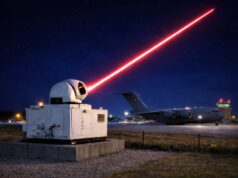The F-35 ‘Integrated Test Force’ recently completed 25 missions comprising of 12 accuracy and 13 separation tests as part of a month long weapons test surge.
Pictured above, F-35 test pilot Maj. Douglas ‘Rosie’ Rosenstock, live fires an AIM-120 Advanced Medium Range Air-to-Air Missile above the Point Mugu Sea Test Range, California.
The 12 Weapons Delivery Accuracy tests and 13 Weapon Separation tests as record breaking say Lockheed Martin as historically, WDAs take place once a month given the coordination required.
We understand that the highest number previously accomplished in a month was three, which occured in November of 2014 during the F-35s 2B software block testing.
According to a press release, these successful test events — performed using the F-35’s newest block 3F software — demonstrated the accuracy of the F-35s.
Five of the test events featured dropping multiple weapons. The F-35 weapons test team was given exclusive use of the Sea Test Range, an instrumented Pacific Ocean test area off the central coast near Point Mugu Naval Air Station, California. Tests were also conducted at the US Navy’s China Lake Weapons Range, California, and the White Sands Missile Range, New Mexico.
Lt. Gen. Chris Bogdan, F-35 Programme Executive Officer said:
“The WDAs rely on the full capability of the F-35 — multiple sensors, navigation, weapons envelope, mission planning, data links and inter-agency range scheduling — all working in sequence to put steel on target. This was a tremendous effort by the F-35 test team. They surged and worked seven days a week for more than a month to expend 30 ordnance and advance weapons testing. This testing has moved us that much closer to delivering the full F-35 capability to warfighters within the next two years.”
During this unprecedented surge period, a total of 30 weapons were dropped or fired, including the Joint Direct Attack Munition, AIM-120 Advanced Medium Range Air-to-Air Missile, GPS-guided 250-pound Small Diameter Bomb and AIM-9X Sidewinder air-to-air heat-seeking missile.
The US Marine Corps declared the F-35B combat-ready in July 2015, the US Air Force declared F-35A IOC on August the 2nd 2016 and the US Navy intends to attain F-35C IOC in 2018.
More than 200 F-35s have flown in excess of 66 thousand fleet-wide hours, with over 300 F-35 pilots and 3,000 maintainers trained to operate and support this next-generation aircraft.
It is expected that the UK will build a front-line fleet of four F-35 squadrons with each squadron having 12 jets. A fifth unit, an operational conversion unit, will also operate 12 aircraft.
In 2015, the UK government’s Strategic Defence and Security Review confirmed a planned order of 138 F-35s, with 23 of them to be available for carrier duties by 2023.
The structure of the Lightning force is now somewhat clear.
- 17(R) Squadron is currently based at Edwards Air Force Base in the US and fills role of F-35B Operational Evaluation Unit.
- 617 Squadron will be based at RAF Marham and will be the first operational British F-35 unit in 2019.
- 809 Naval Air Squadron will also be based at RAF Marham.
- 2 more unnamed frontline Squadrons are to be established.
- 1 Operation Conversion Squadron will also be formed.
Night ops proceeding well at @EdwardsAFB
The Lightning making an unfamiliar sight under NVG pic.twitter.com/OQTwOgOef6— 17 (R) Squadron (@17RSqn) August 12, 2016
The UK will have an operational fleet of around 63 aircraft which is less than half of the total number of F-35’s that the UK has agreed to purchase
However, as reported by AviationWeek, Air Commodore Harvey Smyth pointed out that “the total number would cover attrition replacements and the so-called sustainment fleet, which is defined as additional aircraft required to sustain the fleet to its out-of-service date as well as to cover maintenance. Other UK combat aircraft also have large sustainment fleets.”
The programme is progressing at a steady rate with the Royal Air Force recently starting in-flight refuelling clearance trials of its Voyager tanker with the F-35.
The F-35B’s maiden deployment is set for late 2017 and it’s bound for the Western Pacific. The jet will deploy aboard an amphibious flattop and the US Marine Corps are planning a more powerful escort force to support it, according to Admiral Scott Swift, head of Pacific Fleet, as reported by the Marine Times.
The F-35B has already flown from American assault ships as part of a series of tests, which largely went well.
Additionally, F-35 unit costs have been going down with each successive lot of aircraft and will continue to do so.
17(R) Sqn have three F-35B jets based in the US, we understand that these jets will likely never leave the US.













I’ve heard several mentions of the RAF now wanting to go for the F35A instead of the B versions for the carriers. Is there really any truth in it or just a rumour?
Hope they get them 😀
I believe the RAF want’s F35A to replace the tornado because it has longer range than the F35B, and it want’s mix F35’s fleet, i seen this from flightglobal, but we probably won’t find out if this true unit the next Strategic Defence and Security Review